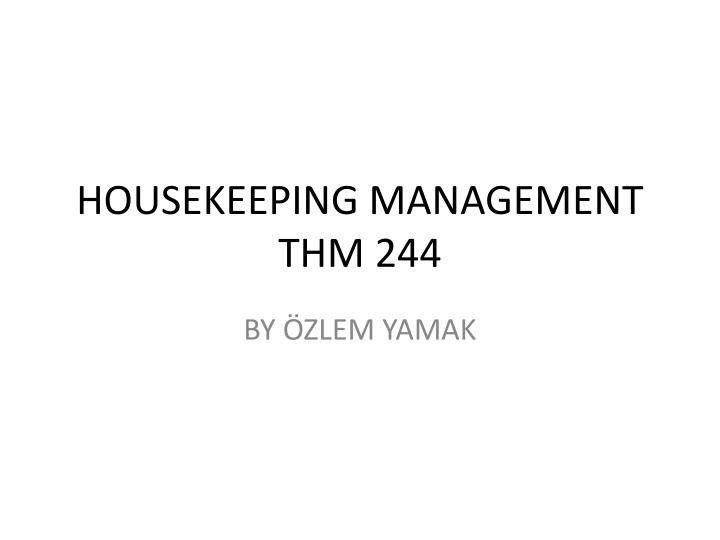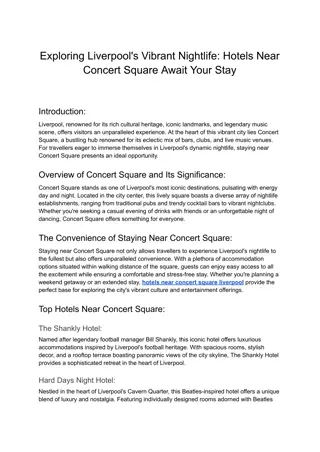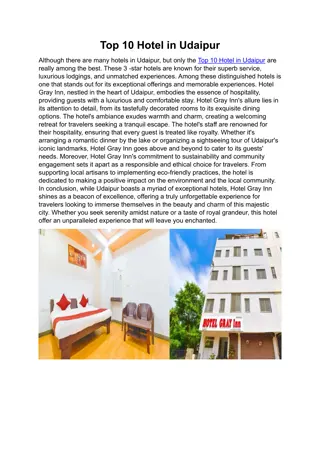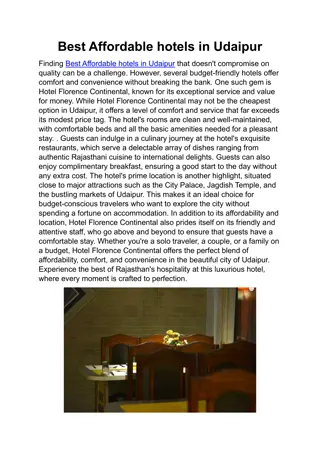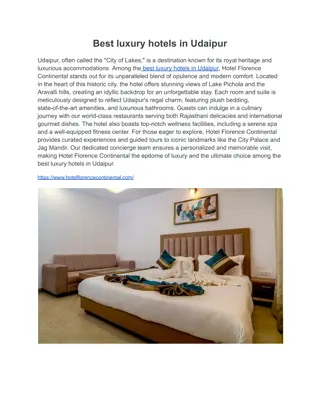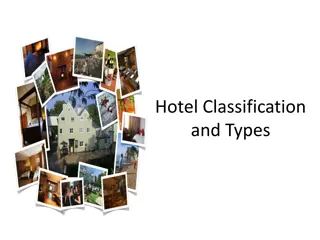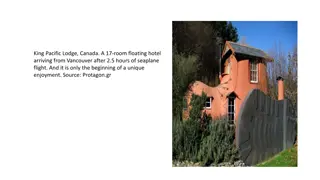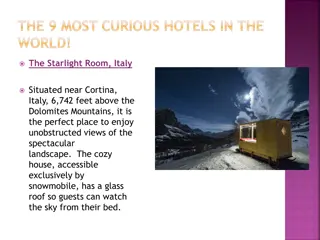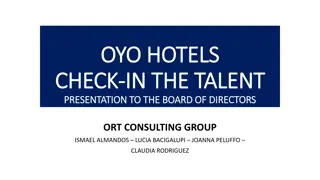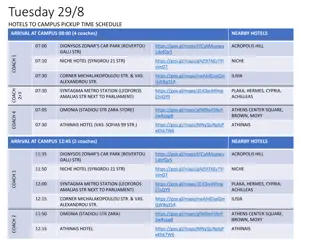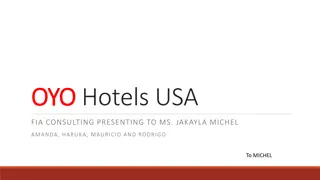Importance of Housekeeping Management in Hotels
Housekeeping management plays a crucial role in maintaining a hotel's reputation for cleanliness and quality. The housekeeping department ensures clean rooms, common areas, and overall appearance, contributing significantly to the guest experience. Without a strong housekeeping staff, the hotel's image would suffer, impacting guest satisfaction and retention. Learn more about the significance of housekeeping in upholding a hotel's standards and attracting guests.
Uploaded on Aug 26, 2024 | 3 Views
Download Presentation

Please find below an Image/Link to download the presentation.
The content on the website is provided AS IS for your information and personal use only. It may not be sold, licensed, or shared on other websites without obtaining consent from the author.If you encounter any issues during the download, it is possible that the publisher has removed the file from their server.
You are allowed to download the files provided on this website for personal or commercial use, subject to the condition that they are used lawfully. All files are the property of their respective owners.
The content on the website is provided AS IS for your information and personal use only. It may not be sold, licensed, or shared on other websites without obtaining consent from the author.
E N D
Presentation Transcript
HOUSEKEEPING MANAGEMENT THM 244 BY ZLEM YAMAK
CHAPTER 1 INTRODUCTION TO HOUSEKEEPING MANAGEMENT OBJECTIVE: housekeeping explaining relationship with the other departments. Describing within role hotel of the and
Why do Guests return to a hotel ? 1. Cleanliness/Appearance 2. Good service 3. Facilities 4. Convenience/ Location 5. Price/Reasonable rates 6. Name/reputation
If sheets are soiled, blankets are rough and scratchy, pillow thin and non-supportive and shower curtains are moldy and stained, the entire image of the hotel is tarnished and the guest most likely will no return. Housekeeping is the impression and last impression. customer s first
IMPORTANCE OF HOUSEKEEPING A hotel s housekeeping-hk. department can be considered the glue that keeps everything together. Withouth a strong hk. Staff, guests wouldn t have clean rooms to check in or return to, the loby would be filthy, furniture and fixtures would be dusty, and the hotel would look unkempt and dirty. Characteristics common to all lodging establishments, regardless of size, category, is the need for hk. services that refreshing . In short, hk. establishes a hotel s reputation for cleanliness and quality. According to Sudhir Andrews, author of Hotel Housekeeping , the hk. Department is vital to attracting and keeping guests through it s role of maintaining top quality decor, cleanliness and service.
IMPORTANCE OF HOUSEKEEPING Housekeepers job include cleaning rooms, changing bedding, cleaning all bathrooms, replacing common areas, doing laundry and ensuring a clean overall apperance. It s easy to see why there are usually more employees working in the housekeeping department than in any other hotel department. toileteries, cleaning It is important to have housekeeping available 24 hours per day 7 days per week for guests in the hotel industry.
Housekeeping Department Largest department in the Hotels. Staff Payroll Responsibility- Eyes and Ears of the Hotel . Maintenance Concerns Guest Behaviour Employee Theft The most vital department in a hotels Highest impact on guests (remember, guest wants cleanliness) Lowest wages paid Least respect received
The aims of the housekeeper are to: Achieve the maximum efficiency possible in the care and comfort of the guests and in the smooth running of the department, Establish a welcoming atmosphere and a courteous, reliable service from all staff of the department, Ensure a high standard of cleanliness and general upkeep in all areas for which she is responsible, Train, control and supervise all staff attached to the department, Establish a good working relationship with other departments, Ensure that safety and security regulations are made known to all staff of the department, Keep the general manager or administrator informed of all matters requiring attention.
THE ROOMS DEVISION Rooms Divisions: Composed of departments and functions which play essential roles in providing the services that guests expect during their stay. Divided into departments that Front Office (front desk, cashier, mail + information section, reservation, telephone), Security, (laundry). Show departments on an organisational chart. Other Departments are: Food and Beverage Department Human Resource Department Accounting Department Sales and Marketing Department Engineering and Maintenance Department and Housekeeping
The executive in charge of the rooms division is the Rooms Division Director/Resident Manager/Executive Manager (Look At Organisational Chart). The rooms Division Director reports directly to the property s general manager. As a member of the executive committee, the rooms division director takes an active part in policy-making decisions related to operations. The front office and housekeeping departments are of critical importance to the property. The Executive Housekeeper is the head of housekeeping and is therefore directly responsible for managing what is in most cases the largest department of the establishment. The position of executive housekeeper in the organisational chart is that of department head, equal in rank to the front office manager, the security manager, and the remaining managers in charge of departments in other divisions. Manager/Senior Assistant
Each department classified either a revenue center or a support center. This method is especially useful for accounting purposes and in relation to the property s recordkeeping and information system. Revenue Center: sells goods or services to guests and thereby generates revenue for the hotel. The Front Office, F&B outlets, room service, and retail stores are typical hotel revenue centers. Support Center: does not generate direct revenue, but plays a supporting role to the hotel s revenue centers. The housekeeping department is a major support center within the rooms division. Others; accounting, engineering and maintenance, HR. The terms front of the house (employees have a great deal of guest contact)and back of the house (employees have less direct guest contact) may also be used to classify hotel departments and the personnel within them. The overall success of an operation depends on the profitability of the rooms division (70-80% of revenue).
COMMUNICATION BETWEEN HOUSEKEEPING & FRONT OFFICE Written Communication Occupancy Report Housekeeping Rooms Status Report Mechanical Communication Computerized Communication
WRITTEN COMMUNICATION Occupancy Report/Night Clerk s Room Report: Prepared by a front desk agent every night, lists the occupied rooms that night, indicates the rooms expected to check out the following day (due out). The Executive housekeeper gets this list in the morning and shedules the rooms for cleaning. Housekeeping Status Report: Prepared by housekeeping department at the end of the shift, indicates the current housekeeping status of each room (the rooms that have been cleaned that day).
based on a physical check of each room Room Status Discrepancy: is a situation in which the housekeeping department s description of a room s differ from the front desk s description of a room. Reasons why discrepancies may occur: Guests switches from one room to another + front desk doesn t change its records. Error is made by the night clerk when filling out the Night Clerk s Report. Guest is given wrong room key by mistake. Room is used by an unauthorized employee. Room is sold by front desk without being recorded, + money is pocketed by the clerk Guest checks in or out between the time report is made + check is conducted. Keeping room status information communication between the front desk + housekeeping department. The two most common systems for tracing current room status are mechanical room rack systems and computerized status systems. up-to-date requires close
MECHANICAL COMMUNICATION A Room rack may be used by the front desk to track the registration process with the guest s name + other necessary information + placed in the room rack slot corresponding to the assigned room number. The presence of the room rack slip indicates that room is occupied. When the guests check out, the rack slip is removed + the rooms status is changed to an on-change. This system may lead to mistakes + delays in the room status information between housekeeping + the front desk. For ex., if a room rack slip is mistakenly left in the rack after the guest s check out, front desk agents may think that a vacant room is still occupied (sleeper). Here the communication between housekeeping + front office may be spoken (on the telephone), written (through the usual reports) or tele- writer.
COMPUTERIZED COMMUNICATION In a computerized room status system, housekeeping and front desk uses a computer terminal which ensures instant access to room status information. When a guest checks out, a front desk agent enters the departure into the computer which alerts housekeeping that the room needs cleaning. After the room is cleaned + inspected, housekeeping enters this information into the terminal. This is how the front office is informed that the room is available for sale. When the computer system is connected to the guestroom telephone system, the supervisors can enter a designated code on the room telephone to change the room s status in the hotel s computer system to inform front desk that the room is ready for sale. This saves time + energy in informing the front desk about the status of rooms. Other Communications: Information about occupancy forecast, arrival of VIP s, early check-in of groups, closing of certain sections for deep- cleaning or repairs, delivery of guest laundr, lost and found items, special guest requests,
SUMMARY OF DAILY COMMUNICATION BETWEEN F. O. + H. K. DEPARTMENTS 6 A. M. Front Office to housekeeping: Daily report of each room s status Rooming lists + times for arriving groups Special requests (adjoining rooms, rollways), VIP rooms Late check-outs Early check-ins 8 A. M. Front office to housekeeping: Check-outs already departed Update of special request and VIPs Assignment of show rooms for the day 10 A. M. Housekeeping to front office: Results of vacant room check Rooms that will not be cleaned today Rooms on maintenance + the reasons
Through the Day Front office to housekeeping: Late departures Extended stays Room changes Check-outs which have departed Housekeeping to front office: Continual reporting of vacant and ready rooms Readiness of special requests Status update of rooms found discrepency Check Out Time Housekeeping to front office: Status of expected check-outs During Check-In Front office to housekeeping: Update on special requests Rooms needed as soon as possible End of the Day Housekeeping to front office: Complete update of hotel status
COMMUNICATION BETWEEN HOUSEKEEPING AND MAINTENANCE Every piece of equipment, fixtures and furniture in the guestrooms, hallways, linen and laundry rooms, public areas and employee locker rooms must be in perfect working order at all times. There are three kinds of maintenance activities 1. Routine Maintenance 2. Preventative Maintenance 3. Scheduled Maintenance Maintenance work order system
1. Routine Maintenance: activities are those which occur on a regular (daily or weekly) basis for the general upkeep of the property. Ex. Sweeping carpets, washing floors, cleaning windows, re-placing burned out light bulbs, cleaning guest rooms, cutting grass. Many of them are handled by housekeeping. 2. Preventative Maintenance: consist of 3 parts: inspection, minor correction, + work order initiation. Every day, the rooms are routinely inspected for any leaks, cracks etc. by room attendants and inspectors. If there are some minor problems, engineering is informed through the telephone + they are corrected while the room attendant is cleaning the room. However, preventative maintenance problems for which work orders are initiated. Then, this type of work is referred to as scheduled maintenance. sometimes identifies major
3. Scheduled Maintenance: activities are initiated at the property based on a formal work order. Work orders are the key in the communication between housekeeping and engineering. When a work order is filled by the housekeeping, one copy is kept in the department and 2 copies are sent to the engineering to inform them. One of those copies is kept by the chief engineer and other is given to the engineering and staff who will fix the problem. TEAMWORK: is the key to successful hotel operations. Housekeeping must work closely not only with the front office and maintenance but also with every other department in the hotel. Although the general manager is responsible for implementing the teamwork philosophy, each department and every employee can help.
CHAPTER 2 & 3 PLANNING AND ORGANISING THE HOUSEKEEPING DEPARTMENT OBJECTIVE: Identifying the major responsibilities and drawing the organisation of the housekeeping department.
HOUSEKEEPING RESPONSIBILITIES Areas of responsibility of the housekeeping department will be different depending on the size of the hotel. In limited service hotels: Guestrooms Corridors Public areas, such as the lobby and public restrooms Pool and patio areas Management offices Storage areas Linen and sewing rooms Laundry room Back-of-the-house areas, such as employee locker rooms
Additional areas in mid-and-world class hotels Meeting rooms Dining rooms Banquet rooms Convention exhibit halls Hotel-operated shops Game rooms Exercise rooms Exceptional areas that not directly responsible for cleaning Kitchen (Food and Beverage) Maintenance department Swimming pool Front desk
MANAGEMENT FUNCTIONS OF EXECUTIVE HOUSEKEEPER Planning (initial activities) Organising/Co-ordinating/Staffing (pre-operating a.) Directing/Controlling (operating activities) Evaluating (appraisal activities)
PLANNING It is deciding where one should go and how to get there. Planning is probably the executive housekeeper s most important management function. Without competent planning, every day may present one crisis after another. Constant crises lower morale, decrease productivity, and increase expenses housekeeper must be addressed all details in order to ensure that the work is not only done- but done correctly, efficiently, on time, and with the least cost to the department. And basic planning activities are: Area Inventory List Frequency Schedules Performance Standards Productivity Standards Equipment and Supply Inventory Levels + Housekeeping Department Operating Budget within the department. Ex
Basic Planning Activities Initial Planning Question 1. What items within this area must be cleaned or maintained? 2. How often must the items within this area be cleaned or maintained? 3. What must be done in order to clean or maintain the major items within this area? 4. How long should it take an employee to perform an assigned task according to the department s performance standards? 5. What amounts of equipment and supplies will be needed in order for the housekeeping staff to meet performance and productivity standards? Resulting Documents Area Inventory List Frequency Schedules Performance Standards Productivity Standards Inventory Levels
Area Inventory Lists are show all the items within each area that will need housekeeping s attention. Preparing area inventory lists is the first planning activity because the lists ensure that the rest of the planning activities address every item for which housekeeping will be held accountable. Lists are bound to be long and extremely detailed. When preparing a guestroom area inventory list, it is a good idea to follow the sequence in which room attendants will clean items and in which supervisors will inspect items. This enables the executive housekeeper to use the inventory as the basis for developing cleaning procedures, training plans, and inspection checklists. For example, items within a guestroom may appear on an area inventory lists as they are found from right to left and from top to bottom around the room.
Frequency Schedules indicate how often items on area inventory lists are to be cleaned or maintained. Items that must be cleaned on daily or weekly basis become part of a routine cleaning cycle and are incorporated into standard work procedures. Other items are inspected on a daily or weekly basis, but they become part of a deep cleaning program and are scheduled as special cleaning projects. The executive housekeeper must take into account a number of factors when scheduling deep cleaning of guestrooms or other special projects. For example, whenever possible, days marked for guestroom deep cleaning should coincide with low occupancy periods. Also, the deep cleaning program must be flexible in relation to the activities of other departments. For example, if the engineering department schedules extensive repair work for several gueast rooms, the executive housekeeper should make every effort to coordinate a deep cleaning of these rooms with engineering s timetable.
Performance Standards are developed by answering the question what must be done in order to clean or maintain the major items within this area? . Standards are required quality levels of performance. Performance standards state not only what must be done, they also describe in detail how the job must be done. One of the primary objectives of planning the work of the housekeeping department is to ensure that all employees carry out their cleaning tasks in consistent manner. Although these are vary from one housekeeping department to another. Important aspect of developing standards is gaining consensus on how cleaning and other tasks are to be carry out. When performance standards are not properly developed, effectively communicated, and consistently housekeeping department suffers because employees will not be performing their tasks in the most efficient and effective manner. The written cleaning standards should be a part of the department s standard operating procedures (SOPs) and strictly observed during the training period of new employees. Experienced housekeepers know the truth of the adage, You can t expect what you don t inspect . managed, the productivity of
Productivity Standards determine the acceptable quantity of work to be done by department employees. An executive housekeeper begins to establish productivity standards by answering the question, How long should it take for a housekeeping employee to perform an assigned task according to the department s performance standard? . Productivity standards must be determined in order to properly staff the department within the limitations established by the hotel s operating budget. However, housekeeping managers must know how long it should take a housekeeping employee to perform the major tasks identified on the cleaning frequency schedules- such as guestroom cleaning once this information is known, productivity standards can be developed. Sample Productivity Standard Worksheet STEP 1 Determine how long it should take to clean one guestroom according to the department s performance standards. Approximately 27 minutes PS: Since performance standards vary from property to property, this figure is used for illustrative purposes only. It is not a suggested time figure for cleaning guestrooms.
STEP 2 Determine the total shift time in minutes. 8 hours X 60 minutes = 480 minutes STEP 3 Determine the time available for guestroom cleaning. Total Shift Time 480 minutes Less: Beginning of Shift Duties .20 minutes Morning Break .15 minutes Afternoon Break 15 minutes End of Shift Duties .20 minutes Time Available for Guestroom Cleaning ..410 minutes
STEP 4 Determine the productivity standards by dividing the result of Step 3 by the result of Step 1. 410 minutes/ 27 minutes = 15.2 guestrooms per 8 hour shift So, quality and quantity can be like two sides of a coin. On one side, if the quality expectations (performance standards) are set too high, the quantity of work that can be done accordingly may be unacceptably low. This forces the executive housekeeper to add more and more staff to ensure that all the work gets done. The challenge is to effectively balance performance standards and productivity standards. Quality and quantity each can serve to check and balance the other.
Equipment and Supply Inventory Levels are needed by housekeeper to get jobs done. The executive housekeeper plans appropriate inventory levels by answering the following question: What amounts of equipment supplies will housekeeping staff to meet the productivity standards of the department? . The answer to this question ensures smooth daily housekeeping activities and forms the basis for planning an effective purchasing system must consistently maintain the needed amounts of inventories. And there are two types of inventory items recycled and non-recycled inventories. be needed for the performance purchasing system. A items in housekeeping
1. Recycle Inventories: items which are recycled during the course of hotel operations. For example, linens, some guest supplies (irons, ironing boards, cribs, etc ), room attendant carts, vacuum cleaners, carpet shampooers, floor buffers and many other items. The number of recycled items that must be on hand to ensure smooth operations is expressed as par number. Par Number: Par refers to the number of items that must be on hand to support daily, routine housekeeping operations. For example, one par of linens is the total number of items needed to outfit all the hotel guestrooms once; two par of linens is the total number of items needed to outfit all the hotel guestrooms twice; and so on.
2. Non-Recycled Inventories: items that are used up during routine activities of the housekeeping department. For example, cleaning supplies, guestroom supplies (such as bath soap), and guest amenities (which may range from toothbrushes, shampoos, conditioners, colognes, etc ). A purchase ordering system for non-recyclable inventory items establishes a par number that is based on two figures: Minimum quantity: the fewest number of purchase units that should be in stock at any time. The inventory should never fall below the minimum quantity. Maximum quantity: the greatest number of purchase units that should be in stock at any time. It must be consistent with available storage space and must not be so high that large amounts of cash is tied up. consumed or
ORGANISING It includes determination of tasks, skills and personnal necessary to achieve objectives of the department. Organising refers to the executive housekeeper s responsibility to structure the department s staff and to divide the work so that everyone gets a fair assignment and all the work can be finished efficiently and on time. Structuring the department s staff means establishing the lines of authority and the flow of communication within the department. Two important principles that should guide the organisation of a department are: Each employee should have only one supervisor (unity of command) Supervisors should have the authority and information necessary to guide the efforts of employees under their direction (span of control) The executive housekeeper delegates authority to supervisors and must ensure that each employee recognizes the authority structure of the department (but can not delegate responsibility). The executive housekeeper is ultimately responsible for the actions of department supervisors. Therefore, it is important that supervisors be well informed about hotel policies, procedures, and the limits of their authority.
The Housekeeping Department Organisational Chart Organisational Chart provides a clear picture of the lines of authority and the channels of communication within the department. People working this departments are: executive housekeeper, assistant housekeeper, uniform room attendants, floor supervisor, public area supervisor, room attendant, housemen, head housemen, desk control supervisor, clock room attendants, night supervisor, horticulturist, head gardener, and gardeners.
COORDINATING is the management function of implementing the results of planning and organising at the level of daily housekeeping activities. Each day, the executive housekeeper must co-ordinate schedules and work assignments and ensure that the equipment, cleaning supplies, linens are on hand for employees to carry out their assignments. STAFFING involves recruiting applications, selecting those best qualified to fill open positions, and scheduling employees to work (More information at Chp. 4) DIRECTING involves supervising motivating, training and disciplining individuals who work in the department. CONTROLLING refers to the executive housekeeper s responsibilities to design and implement procedures which protect the hotel s assets. (More information at Chp. 5). Assets are anything the hotel owns which has value. Example keys, linens, supplies, equipment Managers direct people and control things. EVALUATING is the assesing the extent to which planned goals are attained one of the most important evaluation tool is the monthly budget reports.
CHP. 5 MANAGEMENT OF INVENTORY AND EQUIPMENT OBJECTIVE: Learning how housekeeping material is classified and defining the concepts of fixed and operating assets.
CLASSIFICATION OF MATERIALS Administrative function refers to adequate selection and purchasing of supplies and equipments. Classification of material is a prerequisite to the process of controlling the large number of items used in the housekeeping department. Housekeeping materials is divided into two major categories as: 1. fixed assets, and 2. operating assets.
1. FIXED ASSETS: Items that have a long-term life span, generally over 1 year. Fixed assets are usually cost over $ 100 and depreciated at the end of the fiscal year. Depreciation means that company reduces value of assets during the period of assets estimated useful life. For tax purposes, depreciation is a tax allowance that can be set aside by the company year after year for replacing items once they can no longer be used.
Fixed Assets are sub-categorized into ; 1. F.F. & E ---Furniture, Fixture and Equipment Items that have a 5 to 7 year life span Such as beds, chairs, paintings, mattresses, television sets that are used in guestrooms, public areas, and staff areas. 2. Software Items have a 3 t0 5 year life span Comprise guestroom fixtures of a textile nature that are not bed linens or bath linens Such as curtains, bedspreads, pillows, blankets, comforters 3. Department Equipment Life span of these items is between 3 and 7 years Such as heavier mobile equipment used in the housekeeping department for cleaning or transportation purposes, vacuum cleaners, schampoo machines, glass washers, and so on.
2. OPERATING ASSETS Include items under the control of executive housekeeper that are generally used in the day to day operations of department An important characteristic of operating assets is that it must be regularly inventoried.
Operating Assets are sub-catagorized into ; 1. Cleaning Supplies Includes every one of the items used for cleaning purposes Such as cleaning solutions, disinfectants, polishers, brooms, mops, rags 2. Linens have a sub-categories of bed linen and bath linen Bed linen: includes sheets and pillowcases Bathroom linen: includes towels, washcloths, bath mats and washable shower curtains 3. Uniforms It is self-explanatory, including apparel used in the housekeeping department by supervisors, section housekeepers, laundry, and linen room personnel 4. Guest Supplies: Items used by guests. And sub-divided into 2 classification as non-reusable and reusable items. Non-reusable guest supplies are soaps, pens, paper items, mints, etc. Re-usable guest supplies are items that can be used again, such as ashtrays, clothes, hangers and wastebaskets.
CHP. 6 CHARACTERISTICS OF HOUSEKEEOING EQUIPMENT AND SUPPLIES
Executive Housekeeper must administer and maintain their properties fixed assets classified as F. F. & E., Software and Department Equipment and operating assets classified as Cleaning Supplies, Guest Supplies-non-reusable and reusable-, Linens-bed and bathroom- and Uniforms. For this reason (administration and maintain), executive housekeepers must have appropriate knowledge of the assets that are under their control.
HOUSEKEEPNG F. F. & E., SOFTWARE AND DEPARTMENT EQUIPMENT DESIGN : Regardless of their type of service, lodging properties must maintain interior design consistency standards throughout the building. Its guestroom and public area design, color patterns, fabric and upholstry quality and overall apperance must befit the category they represent. For instance, colors must be complementary. In general blue is complementary of orange, green of red, and yellow is violet (Look at colorstar). Why food companies use red? McDonald s, Wendy s, Burger King as prime examples of this. Using several light tints and shades of the same color makes rooms seem larger, while full-intensity hues tend to make the room compact. Adjoining walls should be painted the same color to provide a sense of continuity. When covering walls, smaller prints should be used in small rooms and in all cases color patterns should be complementary. For instance, lobbies may be fitted with fireplaces, bookcases, and live plants to make them seem more homey and inviting to travelers.
FURNITURE Executive Housekeeper are generally responsible for the refurbishing and upkeep of furniture in guestroom, public and employee areas. Furniture should be: Solidly built, Easy to maintain, Functional, and Attractive. For example, desk chairs should have padded backs to provide comfort to guests (ergonomic) and prevent wood from hitting desktops. In general, guestrooms should provide a warm residential look; for instance, love seats and armchairs can replace the standard chairs so often found in hotel rooms.
Upholstery Upholstery fibers may be natural, synthetic, or plastic. Natural fibers such as cotton, linen, silk and wool are rich looking and long wearing but expensive and delicate to maintain because they stain easily. Synthetic fibers are less expensive and easy to clean but they are less elegant and more likely to generate static electricity. The greatest advantage of upholstery plastic materials such as vinyl is that they can easily cleaned by just wiping with a soapy cloth; however, they generally have a duller appearance than natural or blended materials All fabrics should be strong enough to withstand repeating shampooing.
